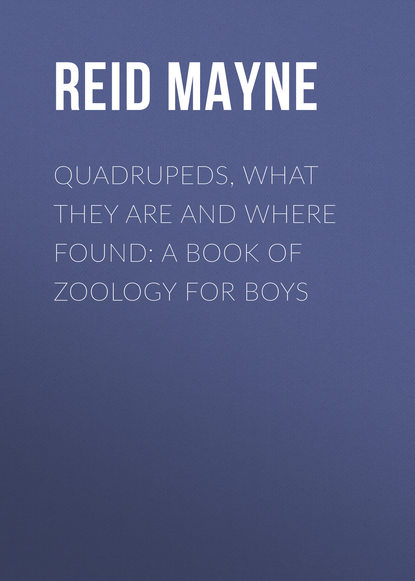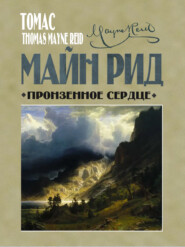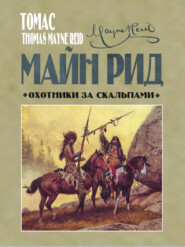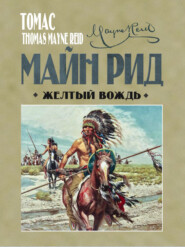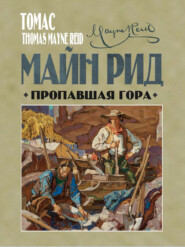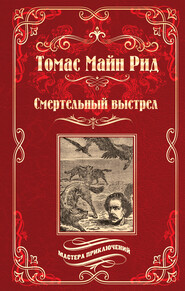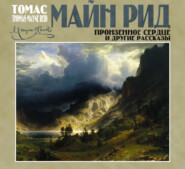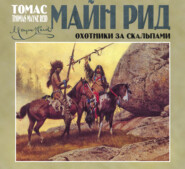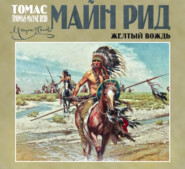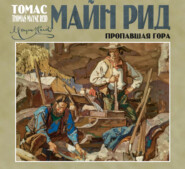По всем вопросам обращайтесь на: info@litportal.ru
(©) 2003-2024.
✖
Quadrupeds, What They Are and Where Found: A Book of Zoology for Boys
Настройки чтения
Размер шрифта
Высота строк
Поля
Fortunate it is that the quadrupeds composing this group are all animals of small dimensions. Were they equal in size to lions and tigers, the human race would be in danger of total extirpation: for it is well-known that weasels are the most ferocious and bloodthirsty creatures upon the earth. None of them, however, much exceed the size of the ordinary cat: unless we include the gluttons and wolverenes among the weasels, as naturalists sometimes do, notwithstanding that these animals differ altogether from them.
The civets, it is true, are not usually classed with the weasels, but form a group of themselves; however, they are much more nearly related to weasels than the gluttons; and where, as in the present case, it is desirable to divide the mammalia into large groups, they will stand very well together. In truth, the civets are much nearer in resemblance to weasels than the otters are; and these two last are generally classed together – the otters being neither more nor less than water weasels.
We shall first consider the true Weasels: that is, the Weasels, Stoats, Ferrets, Polecats, and Martens.
The habits of most of the species are well-known; and all resemble each other in the exceeding ferocity of their disposition. It will only be necessary to say a word about their geographical distribution, and to speak of a few of the more noted kinds.
In Great Britain, five species are natives: the Pine and Beech Martens, the Stoat, the Common Weasel (which is the type of the family), and the Polecat. The Ferret is not indigenous to the country, but has been introduced from Africa, and is trained, as is well-known, for the pursuit of the rabbit – which it can follow into the very innermost recesses of its burrow. The English species of weasels are also common to other countries of Europe and Asia.
In the high northern latitudes of the Old World, we find a very celebrated species – celebrated for a long time on account of its valuable fur – the Sable. The sable is a true marten: a tree-climber, and one of the most sanguinary of weasels. An account of its habits, and of the mode of hunting it, forms one of the most interesting chapters in natural history.
An allied species inhabits the Hudson’s Bay territory, known as the American sable, and another, belonging to the Japanese islands, is called the Japan sable.
The Ermine is a species equally famous; and for a like reason – the value of its beautiful white fur, so long an article of commerce. The ermine is neither more nor less than a stoat in winter dress; but there are several varieties of it – some that turn to brown in summer, while another kind retains its snow-white covering throughout all the year. The ermine is common to Europe, Asia, and North America.
The Pekan is a larger species, belonging to North America, and semi-aquatic in its habits; while the Vison, or Mink, is a large black weasel that inhabits the borders of rivers in Canada and the United States, where it preys upon fish and aquatic reptiles.
In North America there is also a very large Pine marten, so called from its habit of dwelling in the pine forests – where it climbs the trees in pursuit of birds and squirrels. This is among the largest of the weasel tribe. In California, a new species has been described under the name of the Yellow-cheeked weasel, and in Mexico another, the Black – faced; so that North America has its full complement of these sanguinary quadrupeds. Nor is the southern division of that continent without its weasels, as there is one species or more in New Granada, one in Guiana, and two or three in Chili and Peru.
In India, there is the White-cheeked weasel, Hodgson’s and Horsefield’s weasels; and in Nepaul, the Nepaul weasel, and the Cathia. Further north in Asia, there is, in Siberia, the Vomela, the Chorok, and the Altai weasel of the Altai Mountains; and no doubt need exist that animals of the weasel tribe are to be found everywhere. Indeed, if we regard as weasels the various carnivorous quadrupeds of the glutton and badger family, which have been described elsewhere in these sketches – including the strange Teledu or Stinkard of Java, the Helietis of India and China, the Täira and Grison of Brazil, the Ratel or honey badger of Africa, the Zorille of the Cape, the Zorilla or Maikel of Patagonia, the Sand bear of India, and the numerous varieties of the celebrated Polecat, or Skunk, of North and South America – we may well say that there are weasels, or their representatives, in every hole and corner of the earth.
With regard to the Polecats of America, they form a sort of link between the weasels and civets; and although there was long supposed to be but one kind – as in the case of the opossum – it is now ascertained that there are several distinct species, with an endless list of varieties.
The Water Weasels, or Otters, are not so numerous either in species or individuals – though there are at least a dozen of them in all, and they are widely distributed over the world.
In Britain, there is but one – the Common or European otter; and in North America, a very similar species was supposed, until recently, to be the only one inhabiting that continent. The rivers of California, however, have presented us with a second, known as the Californian otter; and the singular Sea otter, whose beautiful fur is so prized under the name of Sea otter, is also an animal inhabiting the coasts of California – as it does most part of the western seaboard of the American continent.
The Grey otter is a South African animal, and in India we have the Wargul; while in the rivers of Nepaul – a country so rich in mammalia – there is the Golden brown otter. China, in common with other Indo-Chinese countries, possesses the Chinese otter; and South America has the Brazilian Contra, and in all probability several other species.
With regard to the Civet-Weasels– or Civet Cats, as they are commonly called – there is a still greater variety, both in genera and species: so many, indeed, that, as already stated, they have been arranged in a family by themselves. They may be regarded, however, as large weasels, distinguished from the others by their having a sort of pouch or gland under the tail, in which is secreted an unctuous and highly odorous substance. This, in some species, as in the true civets, is relished as a perfume or scent, while in others it is an extremely disagreeable odour. The true civet is a native of North Africa; where it is kept in a tame state, for the purpose of obtaining from it the well-known perfume of commerce. An allied species, the Rasse, belongs to Java – and is there also kept in cages for the same purpose – while in Asia – from Arabia to Malabar, and among the Malays and Arabs of Borneo, Macassar, and other islands of the Indian Archipelago – still another species of civet affords a similar perfumed substance.
The Aard Wolf (earth wolf) of South Africa is usually classed among the civets, but with very slight reason. It is far more like the hyena; and is certainly nothing else than a hyena.
The Delundung of Java is a creature that bears a resemblance to the civets; and may be regarded as forming a link between these and the true cats.
The Genets constitute a division of the civet-weasel tribe; and one of which there are numerous species. They are usually pretty spotted creatures, with immensely long tails; and but for their cruel and sanguinary habits would, no doubt, be favourites. They exist in South Europe; and, under different forms and appellations, extend over all Africa to Madagascar and the Cape – as well as through the countries of Southern Asia and the Asiatic islands.
The Ichneumons claim our attention next. These are celebrated animals, on account of the strange and fabulous tales related of the species known as the Egyptian ichneumon, which, among the people of Egypt, is domesticated, and was once held as a sacred animal. Besides the Egyptian ichneumon, there are several other species in Africa – one belonging to Abyssinia, and no less than six to the countries near the Cape. The Garangan of Java is an ichneumon; and so also are the Mongoos and Nyula of Nepaul; while in the Malay peninsula is a species known as the Malacca ichneumon. The Paradoxure is usually classed with the civets, though it wants the perfumed pouch; and the Suricate or Meer-cat, of the Cape colonists, takes its station in this group. A badger-like animal of Madagascar, the Mangu, is also regarded as a civet: so, too, are the Coatis of the New World, though these last are evidently of much nearer kin to the badgers.
Perhaps the curious creature known as the Potto, or Kinkajou, has more pretensions to a place among the civets: at all events, it deserves one in the general group of the weasels.
Chapter Six.
Tame Dogs
Perhaps of all other animals the dog has been the earliest and most constant companion of man. His swiftness and strength, but more especially his highly-developed power of smelling, have made him a powerful ally against the other animals; and these qualities must have attracted the attention of man at an early period – particularly in those times when the chase was, perhaps, the only pursuit of mankind.
No animal is more widely distributed over the earth. He has followed man everywhere; and wherever human society exists, there this constant and faithful attendant may be found – devoted to his master, adopting his manners, distinguishing and defending his property, and remaining attached to him even after death.
It is a question among naturalists as to what was the parent stock of the dog. Some allege that he has sprung from the wolf; others that he is a descendant of the jackal; while not a few believe that there were true wild dogs, from which the present domesticated race had their origin. These ideas are mere speculations, and not very reasonable ones either. It would not be difficult to show, that different kinds of dogs have sprung from different kinds of animals – that is, animals of the same great family – from wolves, foxes, jackals, zerdas, and even hyenas. This can be proved from the fact, that domesticated breeds among savage tribes, both in Asia and America, are undoubtedly the descendants of wolves and jackals: such, for instance, as the Esquimaux dog of the Arctic regions, the Dingo of Australia, the Indian dogs of North America – of which there are several varieties – and also one or two kinds existing in Mexico and South America.
Naturalists deny that there are any true dogs living in a wild state. This is simply an unreasonable assertion. Wild dogs of several species are to be met with in Asia and America; and if it be asserted that these originally came from a domesticated stock, the same cannot be said of the hunting dog of Southern Africa – which is neither more nor less than a wild hound.
Perhaps none of the animals that have submitted to the conquest of man have branched off into a greater number of varieties than this one. There are more kinds than either of horses or oxen. We shall not, therefore, attempt a description of each; but limit ourselves to speak of those breeds that are the most remarkable – or rather those with which the reader is supposed to be least familiar. To describe such varieties as the spaniel, the greyhound, the mastiff, or the terrier, would not add much to the knowledge which the English reader already possesses.
One of the most remarkable of dogs is the huge mastiff of Tibet. He is long-haired, and usually of a jet black colour. He is quite a match in size for either the Newfoundland or San Bernard breeds, and not unlike one or the other – for it may be remarked, that these in many points resemble each other.
The Tibet dog, as his name implies, is the property of the Tibetians: especially the Bhootees – the same people who own that curious species of cattle, the Yäk, or grunting ox, and who reside on the northern slopes of the Himalaya mountains. It may be inferred, therefore, that the Tibet dog affects a cold climate; and such is in reality the case. He cannot bear heat; and does not thrive, even in the kingdom of Nepaul. Attempts to introduce the breed into England have resulted in failure: the animals brought hither having died shortly after their arrival.
The masters of these dogs – the Bhootees, or Bhoteas, are a singular race, of a ruddy copper colour, rather short in stature, but of excellent disposition. Their clothing consists of furs and woollen cloths, adapted to the cold climate which they inhabit. The men till the ground, and keep yäks and sheep, and sometimes come down into the warm plains to trade – penetrating even to Calcutta. The women remain at home, their only protectors being these great dogs, who watch faithfully over their villages and encampments, and fly fiercely at any stranger who may approach them. It is said that they are especially hostile to people who have a white face; but this disposition is also characteristic of the dogs belonging to the American Indians – and perhaps those possessed by all savages with a coloured skin.
The Dingo, or dog of Australia, is an animal domesticated among the aborigines of that country. He is a dog of wolf-like shape, who does not bark, but utters only a mournful howling. He is used by the wretched natives both for the chase and as an article of food; and is a fierce and voracious creature – not hesitating to launch himself on the larger kinds of animals. He is especially employed in hunting the kangaroo; and sometimes terrible combats occur between the dingo and the larger species of kangaroos – resulting always in the death of the latter.
The San Bernard dog, supposed to be a cross between the mastiff and shepherd’s dog, is too celebrated to require a description here. His sagacity in discovering travellers amid the Alpine snows, and guiding them upon their path, is the quality upon which the fame of this dog has been founded; but it may be remarked that many of the feats attributed to him have their origin in the fertile fancies of Parisian writers.
The Esquimaux dog is another celebrated variety. He is an animal with a fox-like face and thick coat of whitish hair, generally tinged with yellow. He is to the Esquimaux a most valuable companion: trained to draw their sledges over the surface of the snow, and enabling them to make long and rapid journeys – without which these singular people would be ofttimes in danger of perishing amid the inhospitable regions they inhabit.
The Indians of North America possess two or three varieties of domesticated dogs, evidently derived from the wolves of that region. Indeed, the common Indian dogs, found among the Sioux and other northern tribes, bear so close a resemblance to the large American wolf, that they are often taken for this animal, and in consequence shot, or otherwise killed by mistake. The Indians use them for carrying burdens: their tents and tent poles being transported by these animals on long journeys across the prairies. Their flesh is a favourite article of the savage cuisine; but it is too costly to be used as an every-day food; and is only served up on grand festive occasions. Like the dogs of Tibet, these Indian wolf dogs have the greatest antipathy to a white skin; so much so, that even a friend in that guise can rarely obtain either their confidence or friendship.
A smaller kind than the common one is found among certain tribes, and appears to have derived its origin from the prairie wolf – the jackal of America – while the Hare Indians of the Rocky Mountains possess a third variety; and it is known that still another exists among the tribes of Russian America. This last is short-haired and smooth-coated: therefore differing altogether from the Indian dogs of the prairies.
In Mexico, there are two or three native dogs: found there on the arrival of Europeans. One is the Alco– a dog remarkable for a curious hunch or protuberance upon the back and shoulders, a thick short neck, and small pointed muzzle. He is thinly covered with long hair, of a yellowish colour.
Another singular variety is the dog of Chihuahua and this is, perhaps, the smallest of all canine creatures. Full-grown specimens have been seen, whose dimensions did not exceed those of the common rat; and a singular fact, well authenticated, is, that this dog, when transported from Chihuahua to any other place – even to the city of Mexico itself – invariably becomes larger, or degenerates, as the Mexicans have it! There is also in Mexico a hairless dog. It is, no doubt, the same as that known by the name of Turkish dog; since this variety came originally from Spanish America.
In South America, there are several species of native dogs, found among the savages of the Orinoco and Amazon. They are small animals, usually of a whitish colour: but their owners follow the curious practice of dyeing them with annatto, indigo, and other brilliant dyes, for the purpose of rendering them more ornamental!
We can only find space to say that there are many other varieties of domesticated dogs, almost unknown beyond the countries in which they are found. Such are the Quao of Rhamgur, the Sumatran dog, the Poull of New Ireland, the dogs of Patagonia and Tierra del Fuego – those of the South Sea Islands; and the Waht that inhabits some of the ranges of the Himalayas.
It is reasonable to suppose that there is not a nation upon earth, hardly a tribe – civilised or savage – that does not possess some variety of the canine race differing from all the others.
Chapter Seven.
Wild Dogs
By Wild Dogs, we mean not only several sorts of true dogs, that in different parts of the world are found living in a wild state; but also Wolves, Foxes, Jackals, Hyenas, and Fennecs – for all these are but dogs in a state of nature.
First, we shall speak of the true dogs living in a wild state – that is, apart from the society of man.
It is not necessary here to go into the often-debated question, as to whether dogs were originally wolves, or what species of wolf the dog is descended from. This is all mere speculation, and answers no purpose. It is just as likely that wolves sprang from dogs, as that dogs came from wolves; and every one may perceive that two breeds of the dog species are often far more unlike each other – both in appearance and habits – than a dog is to a wolf itself. Again, foxes differ only from wolves in point of size; and a small wolf is in reality a fox, while a large fox may be equally regarded as a wolf. Furthermore, the jackal is nothing else than another form of the same animal – the wolf or dog, whichever you choose to term it; and the hyenas but a still uglier shape of the same carnivorous creature.
With regard to the true wild dogs – which are not regarded as wolves – we find them existing in various parts of the world. They usually live in communities, and have the habit of hounds – that is, they hunt in packs. Whether they were originally dogs in a domesticated state, and have since seceded from the society of man, is a question which naturalists are unable to agree upon.
In India there are two or three kinds of wild dogs living thus. One in the Deccan – called Kolsun by the Mahratta people – is a reddish-coloured animal, nearly as large as the common European wolf. It dwells in the forests, far remote from the villages – and of course lives by preying upon other animals – just as wolves and foxes do. Again, in the forests of the Himalaya mountains there is another species of wild dog, different from that of the Deccan. It is usually known as the wild dog of Nepaul, from its being found in many parts of that kingdom. A large community of these animals is often met with in the mountain forests – living in caves, or at the bottoms of cliffs, where there are deep crevices among the boulders of loose rocks, that afford them a secure asylum when pursued by their enemies. In these places the dogs sleep, and bring forth their young; and the puppies are taught to be exceedingly wary, and not stray far from their dens during the absence of the mothers. Indeed, so cunning do they become when only a few days old, that it is difficult to capture one of them outside its impenetrable lodging-place.





